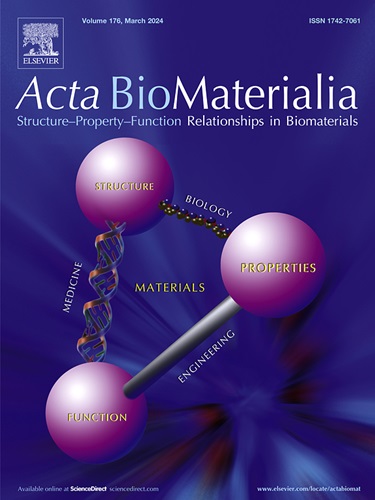用于再生医学的透明质酸的特性裁剪化学修饰。
IF 9.6
1区 医学
Q1 ENGINEERING, BIOMEDICAL
引用次数: 0
摘要
透明质酸(HA)及其基材料因其良好的生物相容性、生物活性和易受化学修饰而广泛应用于再生医学。虽然之前已经总结了HA的反应位点和相关反应类型,以指导HA基材料的化学改性和合成,但化学改性与HA基材料性能之间的关系尚未讨论。本文综述了皮肤、骨骼、软骨、心脏和角膜等组织器官再生医学所需的ha基材料的关键性能,并讨论了旨在实现这些性能的各种化学改性策略。多功能ha基材料可以通过交联和共轭,以及调节内部键合类型和修饰程度来定制。我们还比较分析了常用的ha基材料修饰方法,并讨论了它们的实际优势、局限性以及临床翻译的现状。即使已经取得了重大进展,在精确微调化学修饰,平衡功能和实用性,以及了解它们与体内各种细胞和组织的相互作用方面,仍有很长的路要走。本综述将组织特异性性能需求与化学设计策略联系起来。我们相信这种需求驱动的框架为打算设计具有目标再生能力的ha基材料的研究人员提供了实用和可访问的指南。意义声明:本综述对透明质酸(HA)和HA基材料在再生医学中的应用进行了批判性的研究,重点关注了在特定组织(如皮肤、骨骼、软骨、心脏和角膜)中应用所需的关键特性,以及相关的化学修饰策略。虽然过去已经研究了ha基材料的设计策略,但化学改性与所得材料性能之间的关系仍未得到充分探索。因此,本文通过系统地分类各种针对不同材料性能要求的化学改性策略,提供常用化学改性方法的比较分析,并讨论ha基材料当前的临床挑战和未来方向,解决了这一差距。通过将材料性质与化学修饰策略联系起来,本文综述为研究人员提供了全面的指导,并为推进ha基材料在再生医学中的应用提供了有价值的见解。本文章由计算机程序翻译,如有差异,请以英文原文为准。

Property-tailoring chemical modifications of hyaluronic acid for regenerative medicine applications
Hyaluronic acid (HA) as well as HA-based materials are widely applied in regenerative medicine due to their good biocompatibility, bioactivity and amenability to chemical modifications. Although the reactive sites and associated reaction types of HA have been summarized previously to guide chemical modification and synthesis of HA-based materials, the relationship between chemical modifications and HA-based material properties has not yet been discussed. In this review, the key properties of HA-based materials required for regenerative medicine in various tissues and organs including skin, bone, cartilage, heart and cornea are summarized and various chemical modification strategies aimed at achieving these properties are discussed. Versatile HA-based materials can be tailored through crosslinking and conjugation, as well as regulating the internal bonding types and degrees of modification. We also provide a comparative analysis of commonly used HA-based materials modification methods and discuss their practical advantages, limitations, and the current status of clinical translation. Even with significant progress already achieved, there is still a long way to go in precisely fine-tuning chemical modifications, balancing functionality and practicality, as well as in understanding their interactions with the diverse array of cells and tissues in vivo. This review bridges tissue-specific property demands with chemical design strategies. We believe that this demand-driven framework provides a practical and accessible guide for researchers intending to design HA-based materials with targeted regenerative capabilities.
Statement of significance
This review critically examines hyaluronic acid (HA) and HA-based materials in regenerative medicine applications, focusing on the key properties required for applications in specific tissues such as skin, bone, cartilage, heart, and cornea, as well as the associated chemical modification strategies. While design strategies for HA-based materials have been studied in the past, the relationship between chemical modifications and the resulting material properties remains under-explored. This review thus addresses this gap by systematically categorizing various chemical modification strategies that have been tailored to different material property requirements, providing a comparative analysis of commonly used chemical modification methods, and discussing current clinical challenges and future directions of HA-based materials. By linking material properties to chemical modification strategies, this review thus provides a comprehensive guide for researchers and offers valuable insights for advancing the applications of HA-based materials in regenerative medicine.
求助全文
通过发布文献求助,成功后即可免费获取论文全文。
去求助
来源期刊

Acta Biomaterialia
工程技术-材料科学:生物材料
CiteScore
16.80
自引率
3.10%
发文量
776
审稿时长
30 days
期刊介绍:
Acta Biomaterialia is a monthly peer-reviewed scientific journal published by Elsevier. The journal was established in January 2005. The editor-in-chief is W.R. Wagner (University of Pittsburgh). The journal covers research in biomaterials science, including the interrelationship of biomaterial structure and function from macroscale to nanoscale. Topical coverage includes biomedical and biocompatible materials.
 求助内容:
求助内容: 应助结果提醒方式:
应助结果提醒方式:


